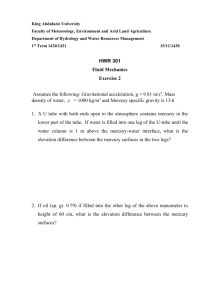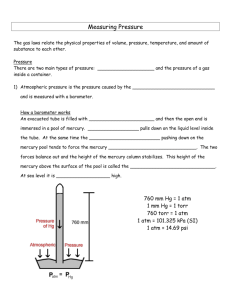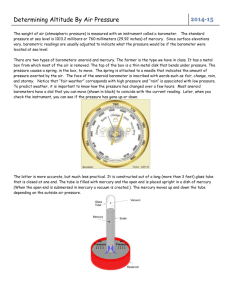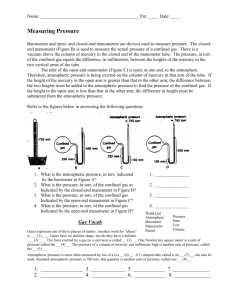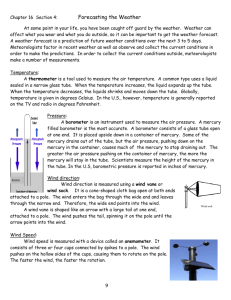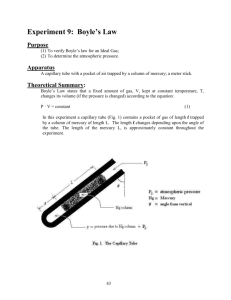Boyle`s Law - Online Simulated Experiment C11-2-05
advertisement
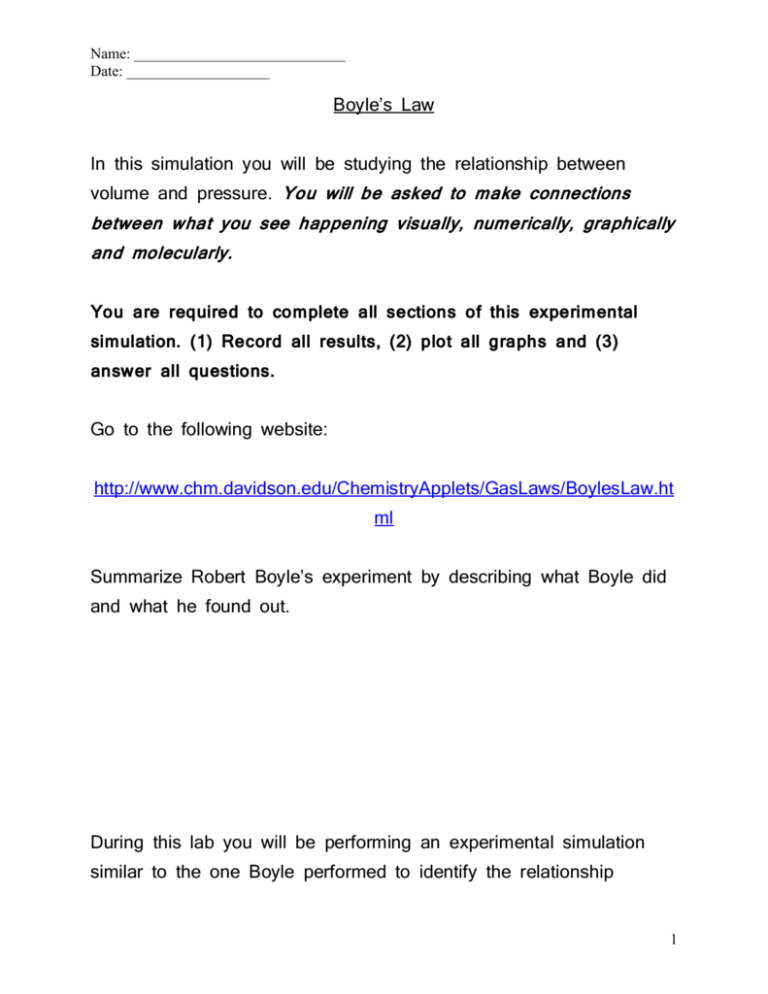
Name: ____________________________ Date: ___________________ Boyle’s Law In this simulation you will be studying the relationship between volume and pressure. You will be asked to make connections between what you see happening visually, numerically, graphically and molecularly. You are required to complete all sections of this experimental simulation. (1) Record all results, (2) plot all graphs and (3) answer all questions. Go to the following website: http://www.chm.davidson.edu/ChemistryApplets/GasLaws/BoylesLaw.ht ml Summarize Robert Boyle’s experiment by describing what Boyle did and what he found out. During this lab you will be performing an experimental simulation similar to the one Boyle performed to identify the relationship 1 Name: ____________________________ Date: ___________________ between volume and pressure. Scroll down and read through the lab. Then begin the experimental simulation. State an Hypothesis for this experimental simulation: __________________________________________________________ __________________________________________________________ ____ __________________________________________________________ __ What type of relationship will it be? (Choose one) One to one? (straight line bisecting graph) Two to one? (straight line steeply sloped) or exponential (Curved line going down). Expalin you suggested answer. Part A Procedure: 1. Calculate the atmospheric pressure in Part 1. 2. Begin the experiment with the open end of the manometer tube at 100 mm. Click the “+Hg+” button until the mercury reaches 100 mm. (You are adding mercury to your manometer) 2 Name: ____________________________ Date: ___________________ 3. Calculate the height of the mercury by subtracting the heights of the two sides of the tubes. 4. Calculate the Pressure of the gas in the closed end of the manometer. 5. Enter the Pressure value into the allotted space in the table below. 6. Calculate the Volume of air in the closed end of the tube by subtracting the height of the mercury in the closed end of the tube (it should read 220) from the height of the tube (1040 mm). Then multiply the height of the air by the diameter of the tube 4.286. 7. Enter the Volume value into the allotted space. 8. Click the “Add Point” button. 9. Repeat steps 2-7 for a mercury level at 200 mm, 300 mm, 400 mm, 500 mm, and 600 mm. 10. Click “V vs. P” and then click “Plot Line”. Draw a representation of the graph in the space provided in the table below. 11. Click “lnV vs. lnP”. Draw a representation of the graph in the graph space provided below. Data and Observations: 1. Copy your Data points into the Table below: Pressure (torr) Volume (mL) 3 Name: ____________________________ Date: ___________________ 2. Draw a representation of the two graphs from the web site. Volume lnV (mL) Pressure (torr) lnP Part B 4 Name: ____________________________ Date: ___________________ Procedure: 1. Raise the mercury column to 800mm. 2. What do you observe about the way the two mercury columns rise up their respective tubes? 3. Explain why this occurs. Observations: Data Analysis for Part A and Part B: Part A 1. Using the Volume vs. Pressure graph, what can you say about the general relationship between the volume of the gas and the pressure the gas exerts? 2. Explain at the molecular level why the force applied by adding the amount of the mercury added changes the gas volume. 5 Name: ____________________________ Date: ___________________ 3. Explain at the molecular level why a change in the gas volume changes the pressure exerted by the gas. 4. What does the shape of the graph (note it is NOT a straight line) suggest is happening to the pressure exerted by the gas as the volume decreases? It is not enough to state it just increases. 5. What type of specific relationship does the lnV vs. lnP graph indicate? 6. What is the proportional relationship between volume and pressure? 7. Write out the mathematical relationship using “k” as your constant. 8. What does this mathematical expression mean? You are best to explain this with reference to ANY two points on the graph. Part B 6 Name: ____________________________ Date: ___________________ 9. Why did the heights of the mercury columns not increase at the same rate? (Think of an explanation using the particles in the gas.) Write a Conclusion including the following points. - Was your hypothesis/prediction correct? Write it in a statement. If not explain how the experimental results were different from your hypothesis. - Was their any experimental error? If so, explain what might have happened. - Summarize the results of the experiment. - What are two practical benefits of this simulation as compared to actually performing the experiment? Application: The relationship between gas pressure and volume is very important to SCUBA divers. Answer the following questions to determine why. 1. SCUBA tanks contain gases under very high pressure. Explain why this is possible. 7 Name: ____________________________ Date: ___________________ 2. What are three practical benefits of having gases in SCUBA tanks under pressure? 3. Explain why air bubbles become larger as they are released from a diver and rise to the surface of the water. 4. The further you go down into the ocean the smaller air bubbles become. As they get smaller they are more able to dissolve in the blood stream and tissues of the body. Explain why it is dangerous to ascend rapidly to the surface of the ocean after SCUBA diving. 8

